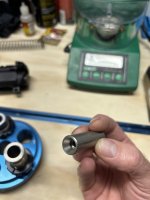Ok, so I'm working on getting my 650 set up to load some bulk range ammo and some precision ammo. I've been gathering all the pieces I believe I need after searching and watching videos. All ammo loaded will be used in Ar's only no bolt guns for this stuff. Im new to loading rifle on this press but have years loading 9mm on it.
What I have so far-
Dillon 1500 case trimmer
Dillon carbide 223 dies
Fosters 223 comp seating die
Armanov tool heads and lockrings
21st Century mandrel die and Black Nitrate Expander set
I was planning on setting up the one tool head to process which is what Ive see others do and recommend. Making sure I have this correct.
Universal Decapping die
Dillon sizer/Trimmer
21st Mandrel Die
Loading Die for range ammo
Dillon sizer/decapper backed out to just use decapper to clear flash hole
Powder drop with dillon measure
Powder check
Dillon seating die
Dillon crimp die
Loading Die for Accurate Ammo
Universal decapper to clean flash hole
Powder drop by hand with funnel
Foster Ultra Mic seater
Foster crimp die
Any recommendations on the best universal decapping die to use? I know dillon is supposed to be releasing their new version based off of the FW.
I still need to get two of them.
I also need to get something to swage with. Ive heard mixed things about the swage it on a 650. Seems most say its fine as long as you stop if you feel it really bind up.
So my question is, anything that anyone would do differently or change. I still haven't loaded a single round yet. I like to make sure I have everything needed and sorted out before I start something.
What I have so far-
Dillon 1500 case trimmer
Dillon carbide 223 dies
Fosters 223 comp seating die
Armanov tool heads and lockrings
21st Century mandrel die and Black Nitrate Expander set
I was planning on setting up the one tool head to process which is what Ive see others do and recommend. Making sure I have this correct.
Universal Decapping die
Dillon sizer/Trimmer
21st Mandrel Die
Loading Die for range ammo
Dillon sizer/decapper backed out to just use decapper to clear flash hole
Powder drop with dillon measure
Powder check
Dillon seating die
Dillon crimp die
Loading Die for Accurate Ammo
Universal decapper to clean flash hole
Powder drop by hand with funnel
Foster Ultra Mic seater
Foster crimp die
Any recommendations on the best universal decapping die to use? I know dillon is supposed to be releasing their new version based off of the FW.
I still need to get two of them.
I also need to get something to swage with. Ive heard mixed things about the swage it on a 650. Seems most say its fine as long as you stop if you feel it really bind up.
So my question is, anything that anyone would do differently or change. I still haven't loaded a single round yet. I like to make sure I have everything needed and sorted out before I start something.


